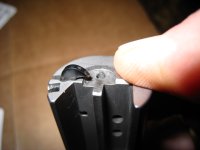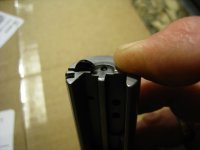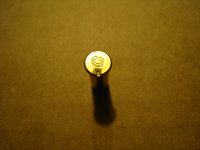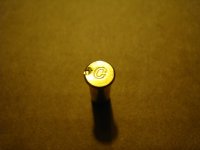You can easily verify the M&P15-22 firing pin projects past the face of the bolt and does not rebound. Keep this in mind if you're thinking of "experimenting" with the rifle. If you load the chamber and then crack the receivers, decock the hammer, and then close the receivers the hammer will be resting on the firing pin and the firing pin resting on the primer. Do not do this, even as an experiment.
1. Remove the bolt group.
2. Take a fairly long straight object (I used a cleaning toothbrush) and press the firing pin flush with the rear of the bolt. The edges of the tool should be resting on the rear of the bolt on both sides of the firing pin -- just like the hammer would be when it smacked it. Note the front of the bolt.
3. No surprises here. The firing pin projects past the face of the bolt as long as the hammer (or test object) is pressing on the rear of the bolt. The face of the bolt is the area within the recess that surrounds the cartridge base on this firearm. It's not a question of "if we consider" the recess to be the face of the bolt, it is the face of the bolt. It's the surface from which headspace is measured. Measuring it from the front of the bolt would be nonsensical.
Face and front are not synonyms. For an extreme example consider the slide of most automatic pistols where the front can be several inches forward from the face.
If you have a M1911 (and every boy should have one) press the firing pin flush with the firing pin stop and note it does not project past the face of the slide. This design uses an inertial (or rebounding) firing pin that allows hammer down on a live cartridge.
-- Chuck






